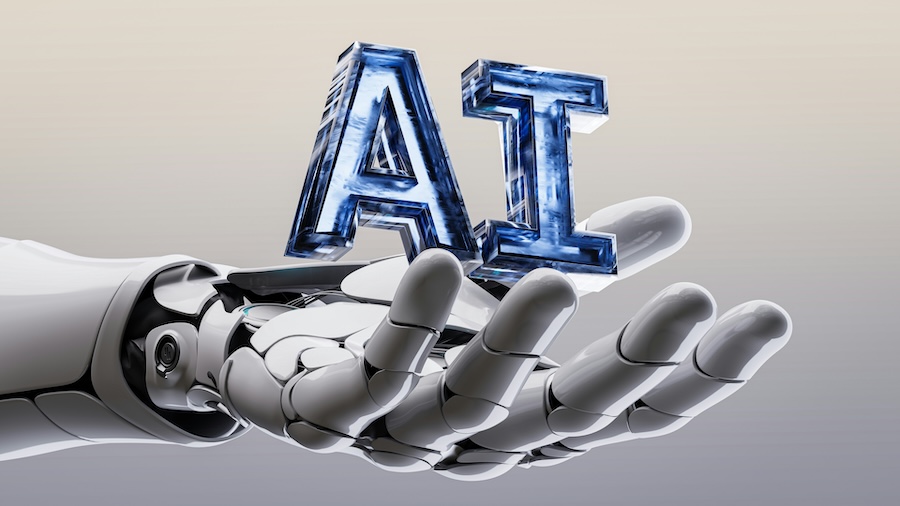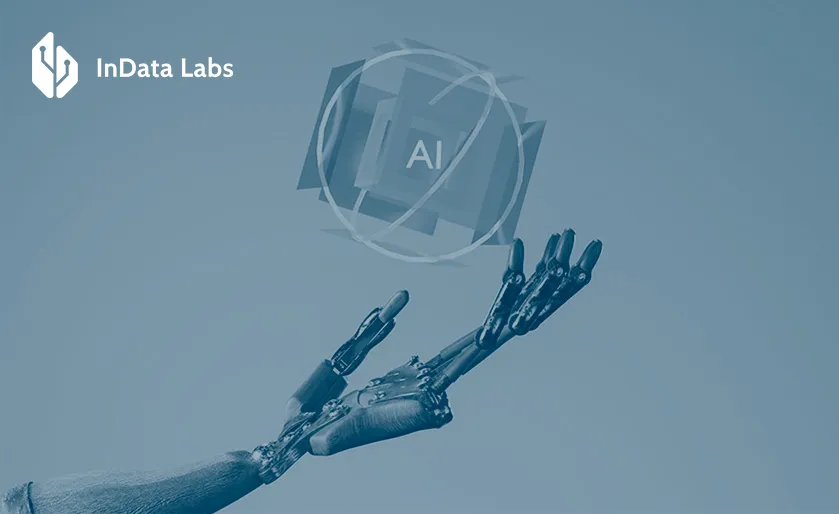AI and NLP technologies can broaden the horizons of your business, so if you want to modernize and improve your brand, it’s a good idea to take a look at embedding them.
According to statistics, over 80% of businesses have embraced AI to some extent, viewing it as a core technology within their organizations. AI is becoming progressively significant in the spheres of strategic planning, corporate finance, and service operations, where almost all industries state approximately 20% utilization in these areas. The sectors of retail service operations and telecom risk management are getting the biggest benefit from AI optimization—their rates stand at 31% and 38%, respectively.

Source: Unsplash
Natural language processing is considered to be one of the most successful areas of AI. If you want to modernize your company, NLP help is business can be very advantageous because of its diversity and ability to bring great results. This article will help you get to know the best AI and NLP technologies which can be advantageous while creating a new business strategy:
1. NLP for improved customer services
NLP (Natural Language Processing) is an area of artificial intelligence. It pays attention to providing computers with the competence to comprehend human language. So as to design programs that can analyze and handle huge amounts of text and words, NLP merges deep learning, machine learning, and computational linguistics.
Natural language processing technology is one of the most extraordinary examples of Generative AI development, because it enables machines to apprehend not only explicit meanings of words but also underlying context, which eventually leads to their coherent interaction with humans. Employing NLP technologies to your business can considerably enhance the level of customer service.
There are a lot of effective AI trends to follow, and creating a chatbot is one of them. NLP plays an imperative role in chatbot advancement by allowing it to figure out human language and respond to users’ requests. It boosts chatbots’ comprehension of grammar, synonyms, and idioms, which eventually gives rise to various advantages like advanced user experience and personalization, better decision-making, and heightened automation.
Another AI-powered text analysis that can boost your customer services is virtual assistance. A virtual assistant is a type of online personal assistant that can help users with daily tasks like making reservations or organizing meetings. Due to NLP, virtual assistants like Alexa, Siri, Google Assistant, and Aurora Borea by InData Labs have become an inherent part of our lives. They rely on NLP technologies so as to comprehend users’ commands, requests and questions.
ChatGPT for NLP is undoubtedly one of the most profitable ways of applying natural language processing services. It should be noted that ChatGPT is also a type of chatbot, but the main difference lies in the use of OpenAI’s generative models to create new responses based on the data it is filled with.
This ability makes ChatGPT more flexible because it can respond to a broad spectrum of questions. Hence, it doesn’t depend on prepared instructions. ChatGPT can also offer more conversational depth since it is trained on more diverse datasets and can create original data. As a consequence, ChatGPT becomes a turning point in accelerating customer service. With text analytics and NLP artificial intelligence technologies, it can fulfill user requests with humanlike accuracy, which eventually leads to advancing customer service experience.

Source: Unsplash
2. Sentiment analysis for company health monitoring
Sentiment analysis is one of the most fascinating natural language processing apps in customer support. Sentiment analysis pursues to detect a fuller background of expression. The sentiment here stands for the emotional message in expression: the emotional tone, opinions, and attitudes that can be covered in writing, actions, or speech.
Companies apply this new AI technology to appraise customers’ emotions and gather data from reviews, social media, and surveys. NLP models can distinguish if the reaction is positive, negative, or neutral, which backs companies to catch customer feedback.
3. Recommender systems for customer review analysis
A recommender system is a form of information filtering system that helps to pinpoint meticulous user preferences by deducing giant data sets. Implementing a recommender system allows for turning raw data into personalized offers. And personalized offers influence higher customer satisfaction, engagement, and sales. Adding recommender systems is constructive for customer review analysis because it can advance customer retention and sales by easily analyzing the market.
It is worth noting that recommender systems would not be so potent without artificial intelligence capabilities which include text analytics and NLP artificial intelligence technologies. AI and NLP in recommender systems enable a deeper awareness of user preferences through the analysis of language. NLP contributes to RecSys by enhancing content analysis, bringing sentiment analysis and personalized interaction, and improving search functionality.
4. Recommender systems for text mining for customer churn prediction
Today’s market is a highly competitive area where it’s imperative to monitor not only incoming customers but also why customers leave – or churn. A business can be adversely affected when it has a high churn rate. Analyzing the existing data will help in predicting potential churners and actions can be taken accordingly.

There are a lot of improvements in customer churn prediction you can achieve with the use of AI. First of all, AI and ML-based churn prediction software can determine customer separation at the onset, which can save costs. Having your gathered customer data, AI-based models can give an explanation to customers’ churn and reduce it.
By tracking buying behavior, inclinations, and transaction history, they can also create accurate customer segmentation, which you can use to create a retention strategy. After applying the strategy to your business, you will face the explicit needs and preferences of your audience and leave problems with churn prediction in the past.
5. AI for improved data investment
When making investments, time and observation are fundamental. Building a prosperous investment strategy demands continuing analysis of huge amounts of data science, including relevant financial data, economic indicators, and other significant factors. But what if we live in a time when the accuracy of your data may change every hour? Sticking to human resources in unstable current market behavior can be time-consuming, resource-intensive and may contain a high risk of calculating things wrong; that is why it’s better to entrust it to innovative ai technologies.
Artificial intelligence technologies help to make timely investment outcomes by collecting and handling data in a time no person can surpass, analyzing diverse risks like market risks, credit risks, operational risks, and forecasting market trends. With well-developed AI systems and business intelligence technologies, companies can efficiently single out probable investment opportunities and make decisions promptly.
AI technology companies can offer you integrated data in a structured way, strategic information, and automated reports, which can alleviate your work with databases, analyzing financial data, and making prompt decisions. As a result, using AI consulting in data investment decreases data crunching time, shortens error and security risks, gives instant access to investment metrics, and simplifies investment management.
6. AI for enhanced work automation
In today’s dynamic business environment, efficiency is not just a goal but a necessity. Nevertheless, traditional workflow automation can’t meet the demands of our constantly developing world. The best decision in this situation will be to use key AI technologies. Your company can open a new domain of opportunities by integrating AI technologies into workflow automation. Using deep AI technologies can make your work automation not only productive but also innovative and capable of getting ahead in an extremely competitive area.
In comparison with traditional work automation systems, AI-driven systems are flexible, self-learning, and capable of unceasing optimization. It makes AI algorithms accustomed to changing circumstances, learn from previous backgrounds, and optimize work processes in a problem-solving time. Along with NLP tools, computer vision, and machine learning, work automation operations can automatize such tasks as data entry, customer interactions, decision-making, and document processing. As a result, using AI for work automation can reduce errors, hasten decision-making, diminish costs, enlarge efficiency, and boost customer service.
7. AI for advanced risk management
It’s hard to imagine a good business strategy without conscientious risk management. It helps to comprehend the twists and turns of the business area, identify possible pitfalls, and plot a course that successfully navigates those challenges. There are a lot of AI technology examples that can impress with how much they have improved the work process, and AI’s work for risk management is not an exception. With AI’s capability to analyze huge amounts of data, it can expose hidden risks, predict possible difficulties, and even find solutions.

Source: Unsplash
AI for risk management has plenty of advantages. First of all, AI technologies can improve accuracy in risk analysis. Unlike human analysis, its algorithms scroll colossal amounts of data so as to identify hidden correlations, anomalies, and trends without losing precision. Continuous monitoring of data doesn’t simply identify risks but effectively manages them. Such perpetual vigilance enhances automation in risk control and also advances efficiency in decision-making. As a result, companies can react to emerging risks with dexterity.
The biggest superiority of new AI technology is that it’s extremely versatile and can be used in every kind of business. AI in business can detect fraud in real-time and save billions. Manufacturing companies can use it to enhance efficiency and diminish supply chain risk, while AI technologies in healthcare can handle compliance risks and ensure patients’ safety. Nevertheless, it should be remembered that AI can’t fully substitute humans and all these effects are possible only when the data is accurate and looked after human intelligence. Also, be careful with you’re the security and privacy of your data so that your delicate information, like financial data or personal details, wouldn’t be leaked to cybercriminals.
Conclusion
Depicting AI with its ability to learn, reason, and accustom sounds like a futuristic concept, but it’s here; it works and constantly develops. With voice assistants on our phones and chatbots which get only better, our lives have become impossible to imagine without AI in them. Few people know that behind these technological advances lies the work of not just AI but NLP. It is NLP technology that provides computers with the opportunity to understand natural languages on the same level as people and eventually streamline the quality of human life. If you want to optimize your company, the best way to do it will be by applying NLP to your strategy.
Using it in your business will enhance customer service, improve data investment, risk management, work automation, churn prediction and so on. The best thing about employing AI and NLP is that these technologies are unceasingly evolving and getting only better.
However, relying on AI’s power completely can be risky or even foolish. AI technologies in your business need to be looked after by human intelligence. But with the right combination of these intelligences, your business will flourish and bring success you couldn’t even imagine.
FAQ
-
Artificial Intelligence (AI) is a form of reproduction of human intelligence by computer systems. Natural language processing (NLP) is a branch of AI which is in charge of computer skills of comprehending and producing human languages on the same level as people do. Without NLP technologies, the communication between people and computer programs in the way we know it couldn’t be possible.
-
Artificial Intelligence (AI) is a science of making computers accomplish tasks on the same level as human intelligence does but without its interference. ML and NLP are the branches of AI. Machine learning (ML) is a process of computer learning from data and making predictions and judgments without having to be deliberately programmed.
The process of learning comes not from a direct solution to the task but from applying it to multiple similar tasks. Natural processing learning (NLP) concentrates on the communication between computers and people with the use of human languages. The ultimate goal of NLP is to understand and use natural languages the way humans do. The primary difference between ML and NLP is that the first one focuses on a variety of data-driven tasks, while the second one works only on comprehending and processing natural languages.
-
NLP provides the opportunity for computers to understand natural languages on the same level as people. To achieve it, NPL needs five essential steps to do.
The first step includes lexical analysis whose purpose is to recognize and analyze word structures by dividing texts into paragraphs, phrases, and words. The second stage includes syntactic analysis, which checks grammar, arranges words, and displays relationships between them. The stage of semantic analysis is responsible for apprehending the literal meaning of words/phrases/sentences and making sentences. The fourth stage is in charge of discourse integration, which includes understanding context. The last step includes pragmatic analysis and focuses on communicative and social content and interpretation.
-
NLP handles various techniques and algorithms to comprehend and process human languages. Data preprocessing and algorithm development are two main processes. With conscientious management of both, an NLP project may turn out to be successful. Data preprocessing concentrates on transforming text data into a format appropriate for inquiry. It includes techniques such as tokenization, word embedding, part-of-speech tagging, and named entity recognition.
Algorithm development refers to making computational models that derive significant information from processed data. It is imperative to develop a successful algorithm so as to enhance language understanding and interaction in NLP applications. Algorithm development includes syntactic and semantic parsing, language models, sentence-to-sentence models, evaluation metrics, attention mechanism, and Bidirectional Encoder Representations from Transformers (BERT).
-
NLP is one of the most well-developed and successful AI branches, which is why it is widely used in almost all industries, from marketing and human resources to healthcare and education. Companies use NLP to enhance user experience, monitor and analyze support, automate support, etc. The most famous techniques where you can find NLP technologies include voice assistants, chat GPT and other chatbots, text analytics, machine translation, and so on.



